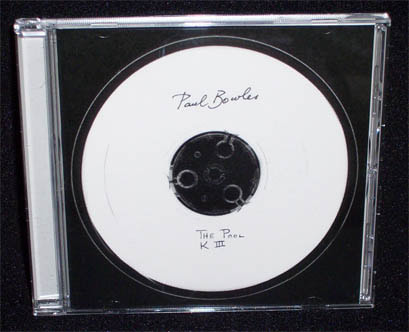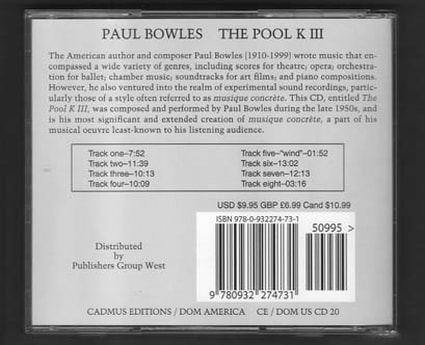|
The American author and composer Paul Bowles (1910-1999) wrote music that encompassed a broad variety of genres, including scores for theatre; opera; orchestration for ballet; chamber music; soundtracks for art films; and piano compositions. Moreover, he also ventured into the realm of experimental sound recordings, particularly those of a style often referred to as musique concrète. Bowles died in November, 1999, in Tangier, Morocco, where he had lived since 1947. Increasingly frail during the last few years of his life, he was unaware that Ramuntcho Matta and Emanuele Carcano had published, in 1998, an experimental piece of his music on Carcano's Alga Marghen CD label without copyright and misattributed the work to the artist Brion Gysin. However, the CD, entitled The Pool K III, was composed and performed by Paul Bowles during the late 1950s, and is his most significant and extended creation of musique concrète, a part of his musical oeuvre least-known to his listening audience. It is Paul Bowles' most unfathomable musical work, one not yielding to easy interpretation and unique to even his own wide-ranging catalog of compositions. It is a realm of sound that creates a dreamlike journey without a clear point of origin or destination—a sojourn to be experienced in its entirety, without stopping. Jon Carlson's notes set forth all the particulars, followed by additional notes from Irene Herrmann and Jeffrey Miller. This Cadmus Editions/Dom America CD of The Pool K III reproduces the Alga Marghen release and restores the work to the music estate of its rightful author, Paul Bowles. |
The Pool K III
Musique Concrète by Paul Bowles composed and performed by Paul Bowles during the late 1950s Cadmus Editions/Dom America CD 20 CD released 2013 8 tracks, 68:96 minutes ISBN 978-0-932274-73-1 $9.95 About the Recording
The following review of The Pool K III by David Kant was published by Tempo Journal, Cambridge University Press, October 2014 THE POOL K III : PAUL BOWLES. Cadmus Editions/Dom America CD20 The Pool K III is an anomaly in Paul Bowles's extensive but still poorly understood musical catalogue. Although Bowles is widely regarded as one of the most important American writers of the twentieth century, his music is less well known. Bowles wrote chamber music and song, as well as opera, ballet and even incidental theatre and film music. The Pool K III, however, appears to be his only work of tape music. Issued by Cadmus Editions/Dom America, this CD is a corrective re-release. The liner notes explain that the recording was previously published on CD in 1998, without Bowles's knowledge, by the Italian music label, Alga Marghen. Bowles had composed the piece in 1958, and circulated it among artistic friends, including Brion Gysin, an artist and writer. After Gysin's death, his artistic collaborator, Ramuntcho Matta, found the tapes and sent them to Emanuele Carcano, director of Alga Maghren, who released the recordings, mistakenly attributing them to Gysin. Gysin and the American author William Burroughs are known for rediscovering, developing, and popularising surrealist cut-up techniques during the late 1950s and early 1960s in both literary form as well as sound poetry. The liner notes document correspondence between Bowles, Gysin and Burroughs from this time (1958-1962). Both Burroughs and Gysin responded to Bowles's tapes with enthusiasm. The Pool K III appears at the centre of a conversation between the three artists about the potential of recording technology, and this release adds another voice to this history of electronic sound: Bowles's. While The Pool K III may be unique within his body of work, recording technology is not. Bowles was fascinated by it. He travelled around Morocco documenting stories and traditional musics, and he even left a tape recorder running in his home to capture conversations. His later theatre music also shows the influence of recording technology. Bowles had a keen interest in the nascent possibilities of recorded sound—especially the relatively new technology of recording tape—and The Pool K III resembles musique concrète, writing that the piece is 'not playing just with music, but with musical sound'. Composed of found sounds, recorded and manipulated with tape techniques, the recordings evoke Tangier, a street band, night or a windy storm. The sounds of dripping water open, close and recur throughout the work. The editing is subtle, minutes passing without a tape splice; changes are minute; sounds return with subtle variation—slight shuffling of layers or small adjustments in manipulation technique. Bowles heard musicality in everything. In an interview with Ira Cohen, Bowles suggests the possibility of electronics for exploring the musicality of any sound, 'from the squeaking of a door, the singing of a bird, or a certain rhythm of a truck on a highway backfiring'. 1 The Pool K III appears to be a realisation of this interest, using electronic tape to articulate the pitches, spectra and echoes of found sounds. The recording of quotidian sounds become musical as the ear settles into their rhythms, melodies and ambient sounds are superimposed, the qualities of one suggested in the other. The Pool K III reflects an influence of North African culture on Bowles, especially Moroccan trance music which embraces states of intoxication. His writing often involved experiments in states of consciousness—dream states, trance states and hallucinations. His book of short stories, A Hundred Camels in the Courtyard, from the same time as The Pool K III features themes of intoxication, as does the included correspondence with Burroughs and Gysin. In his liner notes, producer Jon Carlson explains the confusion of the 1998 Alga Marghen release and documents the research demonstrating Bowles's authorship. The notes include correspondence between Bowles, Gysin and Burroughs, an essay by Irene Herrmann (executrix of Bowles's music estate) and a note by Jeffrey Miller (editor of Bowles's published letters). The release is a detailed and well-documented restoration, and even places Bowles's signature where the 1998 Alga Margen release used Gysin's. The Pool K III is a significant addition to Bowles's body of work. Realising ideas previously only suggested in writings and conversations, it is a remarkable use of tape technology to express the musicality of found sounds. This release restores a public life to the piece, charting a new thread of electronic music history. —David Kant 1 Conversations with Paul Bowles, ed. Gena Dagel Caponi (Jackson, MS: University Press of Mississippi, 1993), p. 13 David Kant is a composer and performer living in the California Bay Area. His work explores the intersection of art and technology, and he takes an interest in human interpretation of computational processes. Recently, Kant has been analysing chaotic circuit networks, recording the sounds of bioluminescent phytoplankton, and using machine listening technologies to deconstruct popular music icons. Kant is pursuing a DMA in Music Composition at the University of California Santa Cruz with advisor Larry Polansky. DOI; Tempo, Published online: 04 September 2014 Review of Paul Bowles's The Pool K III CD by David Kant Tempo Journal, A Quarterly Review of New Music / Volume 68 / Issue 270 / October 2014, pp. 90-91 Copyright © Cambridge University Press 2014 Reprinted with the permission of Cambridge University Press. also by Paul Bowles
No eye looked out from any crevice translations: The Pelcari Project She Woke Me Up So I Killed Her Tennessee Williams in Tangier Paul Bowles reads A Hundred Camels in the Courtyard |
Cadmus Editions
[email protected]
[email protected]


